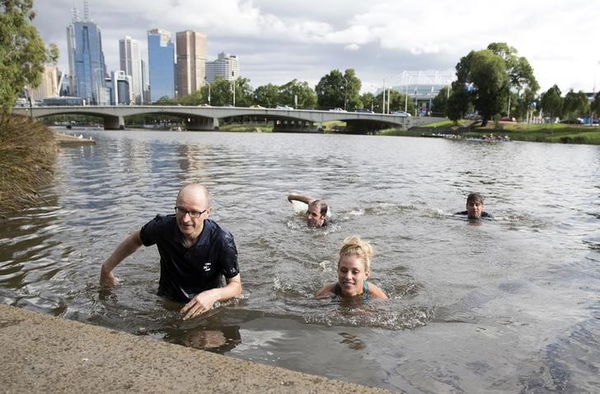
via Reuters
Germany’s Angelique Kerber (C) swims in the Yarra river with a television journalist and members of her training staff, a day after winning her women’s singles final match at the Australian Open tennis tournament at Melbourne Park, Australia, in this January 31, 2016 handout photo. REUTERS/Fiona Hamilton/Handout via Reuters

via Reuters
Germany’s Angelique Kerber (C) swims in the Yarra river with a television journalist and members of her training staff, a day after winning her women’s singles final match at the Australian Open tennis tournament at Melbourne Park, Australia, in this January 31, 2016 handout photo. REUTERS/Fiona Hamilton/Handout via Reuters
Residents of Washington have a double celebration on this year’s Fourth of July. One is the independence and the other is the opening of the Anacostia River to visitors. After more than half a century of a ban on swimming in it, finally, permits for the same have arrived.
Watch What’s Trending Now!
Swimming in the river was illegal in 1971. Due to massive urbanization and sewage release the quality of river water deteriorated. Since then various legislations were passed and campaigns were launched to restore it. After years of dedicated work, the time has come to celebrate with a splash.
ADVERTISEMENT
Article continues below this ad
Splash: An event eagerly waited for a long time
On the 8th of July, the authorities organized an event called Splash. In it, swimmers will be allowed to swim at an appointed place and time. The allotted time for swimming is 20 minutes, between noon and 3 PM, at the Kingman Island Dock near the Benning Road Bridge. The participants should register themselves prior to the event.
Individuals wishing to participate must be at least 18 years old, feel comfortable swimming in deep water, and possess the physical ability to safely ascend and descend a ladder when entering and exiting the water. The event itself will depend on favorable weather and water conditions on the given day.
ADVERTISEMENT
Article continues below this ad
View this post on Instagram
This event, despite limited time, holds a symbolic meaning. It serves as a tribute to the numerous legislative initiatives, infrastructure repairs, and ongoing long-term cleanup endeavors that have collectively brought the river to its current state. Simultaneously, it serves as a reminder that there is still crucial work to be done in the future to ensure the river’s continued progress and restoration.
ADVERTISEMENT
Article continues below this ad
Anacostia River Restoration: Years of dedicated work
The restoration work after the ban did not start immediately. The water quality of the river became the focal point of prolonged legal disputes related to the implementation of the 1972 Clean Water Act. The primary hazard that necessitated the swimming ban was the presence of bacteria present in human waste.
Due to serious effort a consent decree was reached in 2005. It involved the District, the Environmental Protection Agency, the U.S. Department of Justice, and other relevant agencies. This agreement established a comprehensive plan that delineated the necessary actions for the ongoing cleanup process. Remarkably, over a decade has passed since the decree, and the work to restore the river is still in progress. This continuous effort led to happening of events like Splash.
The ongoing work aims not only to remediate past environmental damage but also to ensure the river is resilient and well-equipped to adapt to future climate changes.
Watch The Story: “Pool Fools”: Unique Fundraising Foundation for Diabetes by Mississippi’s Own Hero With Swimming Zest
ADVERTISEMENT
ADVERTISEMENT
ADVERTISEMENT
ADVERTISEMENT


